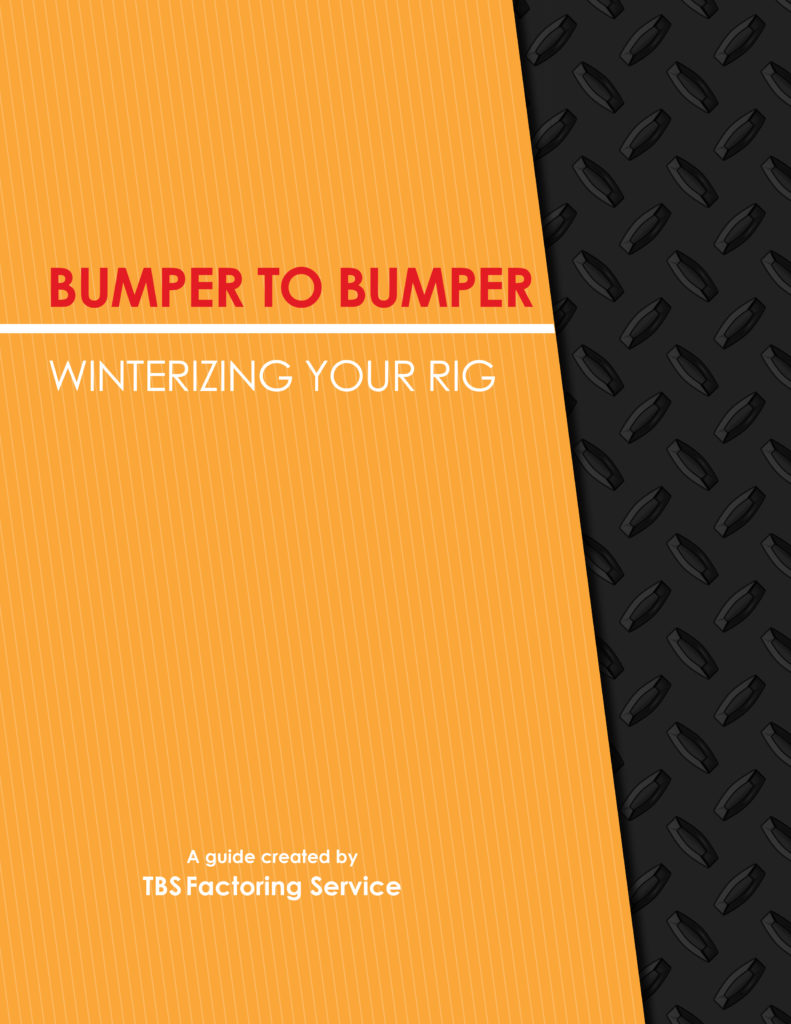Properly preparing and maintaining a vehicle for winter’s challenging conditions is essential to:
- Minimize downtime and its inconveniences and expenses
- Keep down operating costs
- Help maintain vehicle performance and reliability
While the owner’s manual has specific winterizing instructions for each component of your vehicle, the following are some basic measures you can take before the cold weather begins to keep your truck up and running throughout the season.
Chapter 1: Powerplant
Engine
Winter’s frigid temperatures and inclement weather—accompanied by harsh driving conditions—can have a pronounced effect on any vehicle. Winter preparation can minimize vehicle downtime and maintain performance and reliability.
Truck owners with an effective, routine preventive maintenance program in place are ahead of the game because their vehicles are well prepared for the cold. For winter operation, a few components and systems require additional attention to avoid problems.
Make sure the engine is properly tuned and serviced because cold, damp weather can impact engine performance. Oil takes longer to circulate, and the engine takes longer to reach its operating temperature.
Metal cylinder walls become cold when the temperature drops, so most vehicles are more difficult to start in cold weather.
Because diesel engines require much higher temperatures to fire the fuel, they are harder to start in cold weather than gasoline-powered vehicles.
Like hot weather, cold weather also adversely impacts vehicle belts and hoses. The cold, snow, sleet, and road chemicals used for de-icing can accelerate normal wear-and-tear and affect belt and hose longevity and operation.
To help prevent a breakdown, check vehicle hoses and belts for cracking, uneven wear, bulging/swelling, sponginess, etc., and immediately replace faulty belts or hoses.
Engine Oil
If the engine is the heart of the truck, the engine oil is the lifeblood. Especially in winter, it is important that you use the proper oil grade as this will make starting easier.
The Society of Automotive Engineers (SAE)—a global association of engineers and related technical experts in the aerospace, automotive, and commercial vehicle industries—defines oil viscosity (thickness) by grade. Colder temperatures require lower grade oils for correct flow during starting. Higher temperatures call for higher grades for proper lubrication.
Consult your vehicle’s owner’s manual for the recommended oil viscosity.
Also, make sure all engine fluids are at their proper levels. Oil and air filters should be checked regularly and changed when necessary.
Fuel System
As the seasons change, a best practice is to check the diesel fuel grade as well as the cetane rating on the fuel pump. The cetane number measures diesel ignition quality. The higher the cetane number, the easier a diesel engine will start in cold weather.
Diesel fuel is sensitive to temperature. All diesel fuels contain paraffin wax components which, in cold weather, can cause the fuel to thicken (or gel). A buildup of wax components in diesel fuel can obstruct fuel filters and stop fuel from reaching the engine.
Adding a winter anti-gel fuel additive can help prevent the paraffin from gelling together and solidifying. Check the vehicle’s owner’s manual for specific additive guidelines, and always follow them exactly or you risk damaging the fuel system.
Another problem during winter operation is water in the fuel. All fuels contain some water in suspension; however—unlike gasoline—diesel fuel is less refined and will hold a much larger amount of water. As the temperature drops, the water held in suspension will begin to form ice crystals that can cause serious problems.
Fuel gelling, water, and contaminants in fuel directly impact the service life and performance of a vehicle’s fuel system and engine components and can negatively impact fuel economy.
Check fuel tanks and valves for signs of problems. Make certain fuel lines are tight and damage-free. Fuel caps should be tight.
A best practice is to refuel at the end of a day’s operation or before leaving a vehicle standing for an extended period. Why? Condensation forms on the inside of a warm fuel tank as it cools and moisture will condense in an empty fuel tank.
Condensation buildup can be minimized by keeping fuel tanks as full as possible. That helps reduce the chances of costly downtime and expensive repairs.
DEF & DPF
Diesel exhaust fluid (DEF) is a non-hazardous solution sprayed into the exhaust stream of a diesel engine through the Selective Catalytic Reduction (SCR) system. DEF breaks down dangerous nitrogen oxide (NOx) emissions into two harmless by-products: nitrogen and water.
There is no need for concern if the DEF freezes. During vehicle operation, SCR systems provide heat to the DEF tank and lines. The system thaws DEF rapidly and keeps it flowing to the after-treatment system, regardless of the outside temperature.
When shutting down a vehicle overnight or in temperatures where DEF can freeze, a best practice is not to completely fill the DEF tank. This allows the solution to expand when it freezes and prevents the tank from cracking.
The diesel particulate filter (DPF) is part of the emissions control system. It collects diesel particulates in the engine’s exhaust through a complex filtering process wherein the collected particulate is promptly oxidized to remove it from the DPF.
DPFs require proper maintenance throughout the year to ensure the filters adequately reduce emissions, improve fuel economy, and help trucks run quieter. Prolonged service intervals can cause a number of problems, including low vehicle power, engine derate, damaged filters, unscheduled downtime, and breakdowns.
Meteorology Terminology
Important winter weather terms to understand:
- Outlook – Hazardous weather outlooks serve as a heads-up that a significant weather event may be possible in the next seven days.
- Advisory – Issued when winter weather events could cause a significant inconvenience, but could also lead to life-threatening conditions if not cautious.
- Watch – Issued when winter weather events have the potential to threaten life and property but the exact timing and location of the storm is uncertain. Watches are normally issued between 12 to 48 hours in advance.
- Warning – Issued when winter weather events are occurring or are imminent and pose a threat to life and property. Warnings are normally issued between 2 and 24 hours in advance.
Electrical System
The battery, starter, alternator, and cables are the components that make up a vehicle’s electrical system. Each is affected by the vehicle’s operating environment, including cold temperatures, corrosive road de-icers, vibration, etc. The key to electrical system performance and longevity is good preventive maintenance.
Because cold temperatures drain batteries faster, be sure vehicle batteries and the charging system are in good shape and operate properly. A battery’s capacity can be reduced by age and temperature, making it more difficult for a battery to handle the demands of the starter motor.
To help reduce the chances of problems down the road:
- Test the battery’s current state of charge, along with its ability to maintain its voltage during a start cycle.
- Inspect the battery case for cracks, bulges, discoloration, broken terminals, or other damage.
- Be sure all batteries are securely mounted.
- Clean and inspect all battery cables and posts.
- Clean, tighten, and grease all terminals.
- Check the alternator and starter for condition and proper operation.
- Examine the routing and condition of the electrical wiring, checking for fraying, loose connections, exposed or hanging wires, corrosion, etc.
Chapter 2: Brakes & Tires
Brakes
Good brake maintenance plays a critical role in ensuring safe vehicle performance. Consequently, brake condition is a focal point in roadside commercial vehicle inspections conducted by enforcement officials.
Inspect brake lining conditions and check for leaking wheel seals. Ensure proper braking from each wheel, as well as the anti-lock braking system.
Properly functioning brakes keep a vehicle in control and minimize skidding by providing uniform braking.
Air Brakes
Air brake systems need a little extra attention during the winter. Inspect these systems and their components for proper operation. Check valves for function and leakage. Examine the routing of air lines, looking for any damage or potential problems. Drain any condensation in the air system through the air tanks.
Assure proper functioning of the air dryer. If enough moisture—brought in when the compressor draws in air—makes its way through the air dryer, it creates the potential for condensation within the air tanks. When this happens, low temperatures can freeze the condensed water. That increases the likelihood of component malfunctions in the valves, controls, and solenoids used in advanced safety technologies, emissions controls, and automated manual transmissions.
Always use the gladhand dummy connectors on the rear of the tractor cab when the lines are not connected to a trailer. This prevents debris and excess water from getting into the air brake system.
Tires
As winter approaches, a best practice is to give truck tires an extra-thorough inspection, including measuring tread depth in multiple locations around each tire. Higher tread depth enhances traction and stopping distance.
Per the Federal Motor Carrier Safety Administration (FMCSA) regulations, tire tread should be at least 4/32 of an inch for steer tires and 2/32 of an inch for other tires. Replace any tires if they are getting close to those limits or are beneath them.
Examine tires for cuts, sidewall wear and damage, tread punctures, and uneven or excessive tread wear.
For harsh winter conditions, it is best to use tires with an “aggressive” drive axle tread pattern, especially on single-drive axle tractors and straight trucks. A pattern with lots of lugs and gripping edges provides better traction in snow, sleet, ice, and rain.
Tire Inflation
Tire maintenance takes on even greater significance during the colder months. Cold weather reduces tire pressure and low inflation adversely impacts tire life and performance. Check and adjust air pressure frequently.
Unquestionably, the single most critical factor for maximizing tire life and minimizing the chance of catastrophic tire failure is maintaining the proper inflation pressure for a given tire size and load.
When taking an air pressure reading, moist air comes out of the valve stem. This can often freeze on the spot, causing the value to stick. In bitterly cold weather, check tire air pressures in a shop where it’s warmer, which lessens the risk of a stuck valve. If air pressure needs to be added, remember to compensate for the extreme cold pressure drop.
Use tire valve caps and keep them tight. They serve as a cover for the tire valve and prevent damage by blocking debris.
Chains need to be the correct size for the tires and properly installed. Chains that are not tight enough—or chains that are run after they are no longer needed—will shorten the life of the tires.
Chapter 3: Windshields Wipers, Washers, Heaters, & Defrosters
To allow clear vision at all times—particularly in inclement weather—windshields, wipers, washers, heaters, and defrosters need to be in good working order.
Check windshields for minor chips and pitting. As temperatures decrease and sheet metal contracts, stress on windshields can increase. Repair any small chips to avoid crack propagation and the need for replacing the entire windshield.
Examine the condition of the windshield wiper blades and frame and replace if necessary. Look for signs of wear, such as cracking, tears, gaps, discoloration, etc., and check the quality of the wipe.
Check the wiper blades every couple of weeks or so to monitor their condition as it changes over time.
Occasionally wiping down the wiper blades with a clean, lint-free cloth can make a big difference in their wiping ability. It also helps prevent the blades themselves from sustaining damage from contact with dirt or debris.
Always turn off windshield wipers before shutting off a vehicle’s engine. Otherwise, ice, snow, or rain could freeze the blades to the windshield, possibly damaging them the next time the truck is started.
Another best practice is to lift the wiper blades away from the windshield when snow or freezing rain is expected. Besides making it easier to clean the windshield, it also avoids the wiper blades freezing and sticking to the glass—which can damage the rubber squeegee when pulled away.
The heater/defroster must be in proper working condition for driver and passenger comfort and driver visibility. Test their operation, including the function/position of the directional vanes in the system to assure effective defrosting.
To prevent water from precipitation and cold temperatures from freezing your doors shut:
- Park close to a building wall or a large tree. Sometimes these give off just enough heat to make a difference.
- Clean the door frame. Dirt and other debris can prevent the gasket from making a good seal.
- Inspect door gaskets for wear and damage where water can collect and freeze, and replace if necessary. Rub talcum powder or apply a protective lubricant to keep the rubber of the gasket in good shape.
- Clean and lubricate inside door keyholes and any locks with a silicone spray lubricant. If a lock is frozen:
- Spray de-icer into the lock.
- Coat the key with hand sanitizer and gently insert it. Once in place, leave for 30 seconds before turning the key.
- Dip the key into petroleum jelly, put it into the lock and try to move it. This process may have to be repeated a few times, waiting a few minutes between each attempt.
- If carrying a cup of black coffee or tea, dip the key into the hot liquid, dry it off and insert it into the frozen lock.
Chapter 4: Driver Preparation
In addition to properly preparing and maintaining vehicles for winter’s challenging conditions, truck drivers also need to be prepared. The following are some safe winter driving practices from traffic safety professionals.
- Be sure all lights work properly and drive with them on.
- Be alert to changing road conditions.
- Increase your following distance to leave plenty of room to stop.
- Use brakes cautiously and begin slowing down well before a stop. It takes ten times more time and distance to stop on wet, icy, and snow-covered roadways, especially with heavily-loaded vehicles.
- Accelerate slowly and refrain from sudden or jerky movements.
- Signal turns well in advance to give other drivers increased warning.
- Drive appropriately for conditions.
- Allow extra time for traffic delays.
- Clear snow and ice from all windows, lights, and the vehicle hood, and brush them off frequently.
- Be extra cautious when approaching bridges and overpasses as they typically freeze first because of the difference in the exposure to air.
- Maintain a safe distance behind snowplows and maintenance vehicles. Do not pass them on the right.






